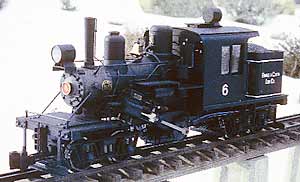1:20.3 scale, gauge 1, 25-ton Class B Climax
Bachmann Industries.
1400 E. Erie Ave.
Philadelphia PA 19124
Price: $799.95
Highly detailed plastic-and-metal model; accurate representation of the prototype; all-wheel electrical pickup; ball-bearings on axles; many metal details; two five-pole motors; directional lighting; cab and firebox lighting; smoke unit; opening doors and windows; engineer and fireman supplied. Dimensions: 153/4″ long over end beams x 41/8″ wide x 61/4″ tall over the cab roof. In 1:20 scale, 26’8″ x 7′ x 10’7″. Tractive effort: 17 ounces, enough for approximately 13 four-axle freight cars. Current draw: 1.25 amps, full slip at 24V.
Pros Outstanding level of detail; excellent owner’s manual; excellent video; die-cast frame; working Johnson bar linked to Stephenson’s valve gear (does not actually affect operation); pre-wired for sound; backhead fully detailed; accurate scale/gauge combination
Cons Necessary lubricants not supplied; elaborate lubrication procedure; unconvincing coal load; truck-mounted knuckle couplers are unsightly; link-and-pin coupler pins difficult to remove; tractive effort seems low
Bachmann set a new industry standard for mass produced, large scale, steam- locomotive models in 1997 when it introduced its Shay. It has met, if not exceeded, its own standard with this new Climax, a model of Pardee & Curtin Lumber Company’s N 6. In short, this locomotive is very, very good.
The level of detail approaches that of a handmade brass model. All valve-gear parts are metal, as are many other details on the engine. The dummy valve gear moves in a prototypical fashion and can even be “reversed” and “notched up” by moving the Johnson bar in the cab. All exposed parts on the prototype are represented on the model and all moving parts on the prototype also move on the model, up to, but not including, prototypical truck gearing. Each truck carries a motor block that contains a five-pole motor. The drive shafts, gearing, and cylinders are all “back-powered” from the motor blocks. Electrical pickup is from all wheels. and all wheels are powered.
The instruction manual and videotape provided emphasize lubrication, which is important on a machine with as many moving parts as this one. It is a pity that the necessary lubricants were not supplied–you must buy them separately. Lubrication is an important and ongoing part of operating this engine. Failure to keep up with it may yield unfortunate consequences.
Link-and-pin couplers (but no links) are provided, but the pins are very difficult to remove. Truck-mounted knuckles are also provided. These extend too far out to look good, but were no doubt done that way to cope with tight-radius curves.
White lettering is sharp and crisp. All parts that should be black are, with the exception of the crossheads. The smokebox is a prototypically dark graphite color. The coal load is shiny and looks artificial, however. Bachmann has provided an engineer and fireman, along with a variety of small detail parts. The figures look toylike when compared to the superb model.
The locomotive runs smoothly and quietly. Top speed at 24V seems good–a trifle fast, perhaps, but logging locomotives are seldom run at top speed. At the slowest speed there was a slight hitch in the mechanism of our review sample. I would expect that to work out over time. The manual clearly says that the locomotive must be run-in at low speeds so that all of the gears and other mechanical parts can wear in properly. We didn’t have time for this breaking-in process before this review was written. Only long-term use will reveal how the myriad small moving parts hold up.
Tractive effort seemed low for the size of the engine. There are no traction tires. The engine drew only 1.25 amps at full slip, so it might be possible to add more weight to improve its hauling capacity.
The engine is available lettered for the Pardee & Curtin Lumber Co. (#81180) or undecorated (#81181). This locomotive should be a valuable addition to any logging or industrial line.














